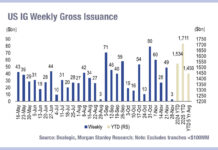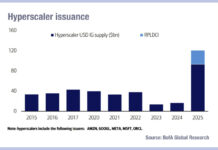The year after next, the UK is set to issue £305 billion gilts to support the government’s spending programme. The high level of issuance in this period is raising concerns about market capacity.

Morgan Stanley economists, Bruna Skarica and Theologis Chapsalis write, “The UK growth picture is still extremely bleak; and the large volume of debt supply in the coming years is likely to bring back concerns about twin deficits and where the demand for gilts is going to come from.”
“In rates, we are confronted with a tug of war,” they added. “For full year 2022-23, the issuance reduction has been significant and above consensus and our expectations. Moreover, the issuance reduction happened through substantially less longs and linkers and we estimate that relative to the 23 September gilt remit, we will receive about £36.5 million/bp less DV01 in this financial year. However, a significant issuance increase is expected in FY2023-24 and the market has clearly taken note of the DMO’s illustrative gross finance numbers. Hence the tug of war.”

Describing the amount being issued in that period as “eye watering”, James Lynch, fixed income investment manager at Aegon Asset Management is also concerned.
“For 2022/2023 we are now going to get £24.4bn less gilts coming between now and March 2023,” he said. “However, from 2023/2024 the number of gilts coming to market is gross £305.1bn which is £113.8bn more than predicted in March 2022 and then £274bn the year after.”
He writes, “For the gilt market that wall of supply is very difficult to price when it is so far in advance and in the short term the borrowing requirements have been cut, but I would not be surprised that yet again in 2023 we will be talking about the market’s ability to absorb a large amount of gilt issuance.”
Let us hope that market structure will be seriously addressed by the UK government and others, as a New Year’s Resolution in 2023.
©Markets Media Europe 2022
©Markets Media Europe 2025








